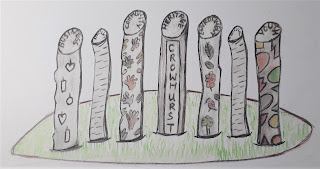I've just started a creative writing course. In lesson one we learned about free writing which basically means you just keep writing without stopping to think. Interesting exercise that ended with a paragraph about how much my hand was starting to hurt after 5 minutes of non stop scribble.
The homework was to write 1000 words on the subject of 'Rituals'. It had to be started using the free writing method and then edited down. Mine edited down to a paltry 500 words but here it is anyway.
The homework was to write 1000 words on the subject of 'Rituals'. It had to be started using the free writing method and then edited down. Mine edited down to a paltry 500 words but here it is anyway.
Rituals
Apart from weddings, christenings
and funerals, I don't do rituals except breakfast. I'm lucky - my partner gets
up much earlier than me so I wake up and smell the coffee every day.
I get up, go downstairs, slice
the bread and put it in the toaster. I pour the coffee into the same mug. Then
I butter the toast and spread marmite on one piece and marmalade on the
other. I go to the kitchen window where I sit on a stool, sipping and munching
and staring out into the garden.
Every day I see some, or all of the
following: goldfinches, chaffinches, nuthatches, woodpeckers, blackbirds, robins.
Blue, coal, great and long tailed tits. Sometimes a thrush, a bullfinch, a
goldcrest. Wood Pigeons, ring-collared doves, magpies, jackdaws and the inevitable
squirrels.
I also see fifty shades of green
emerging from the grey silence of winter. Then watch fifty more, dappled in
breezy sunlight, become part of the falling spectrum of autumn rain.
I see
human rituals mirrored from that window - a constant stream of marriages,
births and deaths. Some of the deaths natural, some accidental or unexplained
and the occasional cold-blooded murder.
I’ve
read that crows and other birds hold roadside funerals for their fallen
comrades. Sometimes, when a crow is killed by a passing car, a murder of
fellow crows will descend and walk circles around the dead bird for 15 to 20
minutes. The crow’s close relative, the magpie, holds similar services and
has even been seen placing tufts of grass alongside the departed. Is this
a ritual or is it only humans to which that word applies?
As for the marriages, there may not
be a formal ceremony with invited guests but birds pairing off can be preceded
by violent competition, acrobatic aerial courtship and virtuoso musical
performances. Then comes the explosion of chicks from early spring to late
summer often accompanied by behaviours that look a lot like love. I often wonder
if that first trip to the bird feeder with the parents is an avian coming of
age ritual.
My experience of the human rituals
is that they provide families and friends with regular opportunities to remind
themselves and each other that they are part of something larger. There is a collective
unity in celebrating together, grieving together and marking time. Recognising
change and its impact, not only on yourself but on those who are a fixed part
of your life.
Having managed to remain a romantic,
I like the wedding ritual but the births are obligations I could do without.
Funerals, on the other hand are getting much more interesting as I get older. Partly
because I am no longer just a spectator but often have some role in proceedings
and funerals have changed. They are now equally as likely to be celebrations of
a life, as a mourning of a death. It is still as painful whatever you call
it.
Marriages have also changed and can
have counterpoint divorce rituals now, although I am not sure that the guests
at the first party will all be attending the second.
My breakfast ritual won’t change.
Not for a while at least. I will still wake up and smell the coffee. I will
still look out of the window, fixed in the present and be reminded that the
cycle of nature is eternal, that birds never waste time and that squirrels
are fucking geniuses.




























